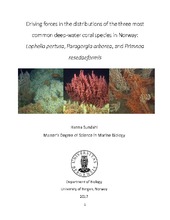| dc.contributor.author | Sundahl, Hanna Sofia Slensvik | |
| dc.date.accessioned | 2018-01-17T13:02:17Z | |
| dc.date.issued | 2017-12-20 | |
| dc.date.submitted | 2017-12-19T23:00:01Z | |
| dc.identifier.uri | https://hdl.handle.net/1956/17230 | |
| dc.description.abstract | This thesis explores a set of environmental variables may be used to predict the spatial distribution of the three most common cold-water coral (CWC) species in Norway: Lophelia pertusa, Paragorgia arborea, and Primnoa resedaeformis. CWCs are important biogenic habitats that provide substrate and living space for a variety of deep-sea sessile organisms and commercially important fish, but are threatened by various anthropogenic impacts (e.g. bottom trawling, petroleum exploration and mineral mining), leading to increased efforts to appraise and protect them. Deep-sea exploration is difficult due to cost, time and access constraints, so in order to target protection efforts, species distribution models (SDM) can be created to find areas with the highest probability of species presence. The Maximum Entropy (Maxent) 3.4.1 program was used on CWC presence data and several environmental variable layers covering the Norwegian continental shelf from the southern end of Norway to Svalbard. Data on CWC presence positions from MAREANO video records for all three species together with the IMR Lophelia Reef Database with additional Lophelia presence points were used. The environmental variables were: depth and terrain proxies from a bathymetry layer (processed to 176 x 176m resolution) from EMODnet, oceanographic variables from the Norkyst-800 model, surface chlorophyll a concentration from the Ocean Biology Processing Group in NASA, and sediment and marine landscape type as defined by NGU. Data was prepared and visualized in ArcMap 10.5.1 and environmental characteristics at CWC presence points were summarized in Excel prior to modeling. Maxent produced SDMs that indicated high probability of presence especially on the continental margin and along the Norwegian coast and near fjords. Jackknife tests showed that sediment was particularly important for the gorgonian corals, while chlorophyll a uniquely predicted well for Lophelia. Depth, mean current speed, marine landscape, and slope were important individual indicators of presence for all. The hope is that information gained from the modeled distributions and predictor variables used will help conservation efforts for Lophelia, Paragorgia, and Primnoa. | en_US |
| dc.language.iso | eng | eng |
| dc.publisher | The University of Bergen | en_US |
| dc.subject | ArcGIS | eng |
| dc.subject | Maxent | eng |
| dc.subject | Primnoa resedaeformis | eng |
| dc.subject | cold-water corals | eng |
| dc.subject | Paragorgia arborea | eng |
| dc.subject | Lophelia pertusa | eng |
| dc.subject | species distribution modeling | eng |
| dc.subject | Dypvannskoraller | nob |
| dc.subject | Dypvannsrev | nob |
| dc.subject | Dypvannsøkologi | nob |
| dc.subject | Økologisk modellering | nob |
| dc.subject | Biogeografi | nob |
| dc.subject | Norskekysten | nob |
| dc.title | Driving forces in the distributions of the three most common deep-water coral species in Norway: Lophelia pertusa, Paragorgia arborea, and Primnoa resedaeformis | en_US |
| dc.type | Master thesis | |
| dc.date.updated | 2017-12-19T23:00:01Z | |
| dc.rights.holder | Copyright the Author. All rights reserved | en_US |
| dc.description.degree | Master's Thesis in Biology | en_US |
| dc.description.localcode | BIO399 | |
| dc.subject.realfagstermer | https://data.ub.uio.no/realfagstermer/c006677 | |
| dc.subject.realfagstermer | https://data.ub.uio.no/realfagstermer/c011814 | |
| dc.subject.realfagstermer | https://data.ub.uio.no/realfagstermer/c009388 | |
| dc.subject.realfagstermer | https://data.ub.uio.no/realfagstermer/c030582 | |
| dc.subject.realfagstermer | https://data.ub.uio.no/realfagstermer/c009584 | |
| dc.subject.realfagstermer | https://data.ub.uio.no/realfagstermer/c003338 | |
| dc.subject.nus | 751999 | eng |
| fs.subjectcode | BIO399 | |
| fs.unitcode | 12-60-00 | |
| dc.date.embargoenddate | 2018-10-16 | |
